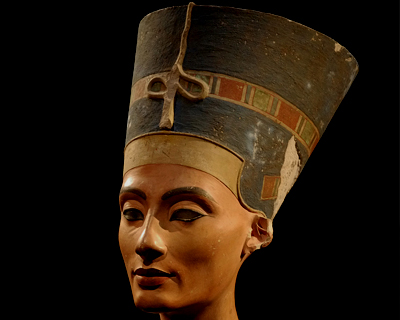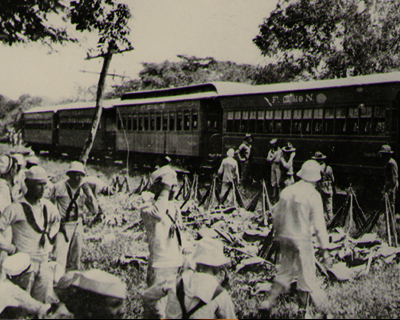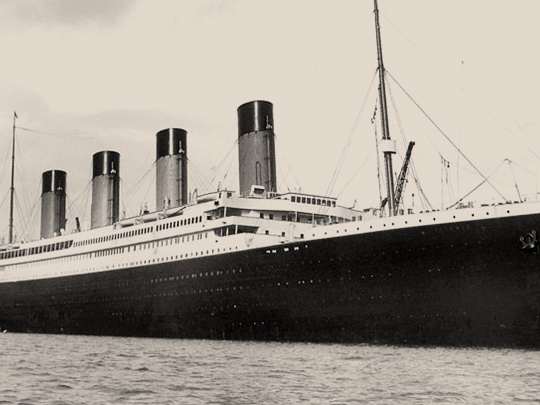F.G.O. Stuart / Wikimedia Commons / CC-BY-SA-3.0 / GFDL
1 – Titanic Sinks After Hitting an Iceberg
The sinking of the RMS Titanic occurred late on April 14th in the North Atlantic Ocean, four days into the ship’s maiden voyage from Southampton to New York City.
The world’s largest passenger liner at the time, there were 2,224 people on board when it struck an iceberg at around 23:40 (ship’s time) on April 14th, 1912. It was thought to be ” practically unsinkable”.
On that fateful night, there had been reports of ice from other ships, but Titanic was sailing on calm seas with no danger in sight.
Then, a lookout saw an iceberg in front coming out of a slight fog and raised the alarm. The engines were reversed and the ship turned sharply.

Instead of making a direct impact, the ship only seemed to graze the side of the berg. However, a jagged spur had made a 300-foot gash well below the ship’s waterline. With 6 of the 16 compartments filling with water, it was the beginning of the end.
Almost all those who jumped or fell into the water drowned within minutes due to the effects of hypothermia. The RMS Carpathia arrived on the scene after the sinking, with the last of the survivors rescued around nine and a half hours after the collision.
The sinking resulted in the deaths of more than 1,500 people, making it one of the deadliest peacetime maritime disasters in history.
The disaster caused outrage over the lack of lifeboats, lax regulations, and the unequal treatment of the three passenger classes during the evacuation.
Subsequent inquiries recommended sweeping changes to maritime regulations, leading to the establishment of the International Convention for the Safety of Life at Sea (SOLAS), which still governs maritime safety today.
2 – Bust of Queen Nefertiti Found

The Nefertiti bust was found on 6 December 1912 in Amarna, Egypt, by the German Oriental Company, led by German archaeologist Ludwig Borchardt.
It was found in what had been the ancient sculptor Thutmose’s workshop, along with other unfinished busts of Nefertiti. The work is believed to have been crafted in 1345 BC.
Nefertiti was the wife of the Egyptian Pharaoh Akhenaten. With her husband, she reigned at what was arguably the wealthiest period of Ancient Egyptian history.
Some scholars believe that Nefertiti ruled briefly as Neferneferuaten after her husband’s death and before the accession of Tutankhamun, although this identification is a matter of ongoing debate.
Since the discovery, Nefertiti has become one of the most famous women of the ancient world, and an icon of feminine beauty.
The bust is currently on display at the Neues Museum in Berlin.
3 – U.S. Marines Invade Nicaragua

The formal occupation began in 1912, even though there were various other assaults by the U.S. in Nicaragua throughout this period.
American military interventions in Nicaragua were designed to stop any other nation except the United States of America from building a Nicaraguan Canal.
Adolfo Díaz, relying on the U.S. government’s traditional support of the Nicaraguan conservative faction, made clear that he could not guarantee the safety of U.S. persons and property and requested U.S. intervention.
In the first two weeks of August 1912, Luis Mena and his forces captured steamers on Lakes Managua and Nicaragua that were owned by a railroad company managed by U.S. interests.
Under this backdrop, USS Denver and seven other Pacific Fleet ships arrived at Corinto, Nicaragua from late August 1912. USS Denver, arrived at Corinto on August 27, with 350 navy bluejackets and marines on board.
Their priorities were to re-establish and safeguard the disrupted railway and cable lines between the principal port of Corinto and Managua. Of the 1,100 members of the United States military that intervened in Nicaragua, thirty-seven were killed in action.
After Díaz safely in the presidency of the country, the United States proceeded to withdraw the majority of its forces from Nicaraguan territory, leaving one hundred Marines to “protect the American legation in Managua”.
The United States occupation of Nicaragua from 1912 to 1933 was part of the Banana Wars when American troops forcefully intervened with various Latin American countries from 1898 to 1934.
